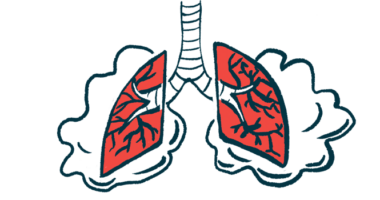Trikafta Increases Microbiome Diversity in Lungs, Study Shows

The microbiome diversity in the lungs of cystic fibrosis (CF) patients increased after treatment with Trikafta, becoming similar to a person without CF, an analysis showed.
In addition, small molecule metabolites produced by cells varied widely across patients while on the therapy, with the largest decrease seen in amino acids (building blocks of protein) or short chains of amino acids known as peptides.
“A reduction of amino acids and peptides in lung mucus may be unfavorable to pathogens that preferentially metabolize these nutrients, leading a different future for the CF lung microbiome with widespread availability of [Trikafta],” the researchers concluded.
The study, “A restructuring of microbiome niche space is associated with Elexacaftor-Tezacaftor-Ivacaftor therapy in the cystic fibrosis lung,” was published in the Journal of Cystic Fibrosis.
The buildup of thick mucus secretions in the lungs and digestive tract is a hallmark of CF. Patients with severe disease are afflicted by chronic lung infections through their lifetime, especially those carrying at least one copy of the F508del CFTR mutation, the most common CF-causing genetic defect.
The microbiome of the CF lung includes viruses, bacteria, and fungi. Over time, opportunistic pathogens, such as the bacteria Pseudomonas aeruginosa, begin to dominate. The composition of the microbe-inhabited mucus also contains DNA, amino acids, antibiotics, inflammatory fatlike lipids, and a collection of other small molecules.
Trikafta is a combination of three CF medications: elexacaftor, tezacaftor, and ivacaftor. The therapy is approved to treat CF patients with at least one copy of the F508del mutation. Clinical trials and post-approval data have demonstrated Trikafta significantly improves lung function and other CF symptoms.
“It’s amazing,” study senior author Robert Quinn, PhD, in the College of Natural Science at Michigan State University, said in a university press release. “Patients were reporting a decrease in symptoms within weeks.”
Trikafta therapy also may increase the life expectancy of CF patients, including young children who begin early treatment. “They might never have to experience the symptoms of cystic fibrosis in the same way prior to Trikafta,” Quinn added.
However, little is known about how the therapy affects the CF lung microbiome and metabolome — the collection of all small molecule metabolites produced by cells, which provides a direct readout of cellular activity.
In this study, funded by a National Institute of Allergy and Infectious Disease grant, Quinn and his team collected sputum samples (a mixture of saliva and mucus coughed up from the respiratory tract) from 24 adult CF patients before and after Trikafta treatment and analyzed the impact on the microbiome and metabolome.
Sputum samples were collected during clinical visits, in which the first sample was collected within one year of Trikafta administration and the second sample within one year after. The collection of sputum samples from Trikafta-treated patients, however, posed a challenge.
“The thing that makes life better for patients is making the research more difficult,” Quinn said. “Trikafta reduces the amount of sputum (mucus) in the lungs, which is life-changing for the patients, but if we don’t have any mucus to sample, it’s difficult to learn about what lung infections will look like in the future.”
With enough sample collected, the microbiome was studied by RNA analysis, while the metabolome data was generated using a technique called LC-MS/MS.
To serve as a comparison control group, publicly available microbiome and metabolome data from a previous study were included, with a similar collection time between paired samples but before Trikafta approval.
Lung function across the patient group significantly increased after Trikafta therapy, whereas patients in the control group did not show changes in lung function. Antibiotic use before and after treatment was not significantly different.
After Trikafta therapy, there was a significant increase in the microbiome alpha-diversity — the number and relative abundance of microbes within a particular sample. In comparison, the alpha-diversity of the control group did not show a significant difference before Trikafta approval. The metabolome did not show a substantial change in alpha-diversity after therapy, but the number of molecular features decreased significantly.
Antibiotics found in the metabolome did not correlate with alpha-diversity changes and were not significantly different before or after therapy. Changes in lung function also did not correlate with a change in microbiome diversity.
After Trikafta therapy, there also was a statistically significant change in beta-diversity — the relative overall similarity between samples. “The overall microbiome profiles of the sputum samples changed after [Trikafta] therapy,” the researchers wrote.
Results showed a greater change in the metabolome profile after treatment compared with changes in the microbiome, which indicated that “the overall changes in the two data types occurred similarly, despite subjects having different initial profiles,“ they added.
The lowest variation in microbiome data was seen with participants before and after treatment, “indicating that although the microbiome profiles change significantly, individuals were still more similar to themselves before and after therapy than across the [group],” the scientists noted.
Before Trikafta therapy, metabolomes were the most similar across individuals. Still, the largest beta-diversity in metabolite profiles was found across patients in samples collected during treatment, “signifying that the chemical makeup of sputum becomes far more varied across people once administered [Trikafta],” they added.
There were no significant changes in the classes of microbes after therapy. Although there were changes in Pseudomonas bacteria in some patients, this was not significantly different in the overall paired data.
The most substantial metabolomic change due to Trikafta therapy was a decrease in amino acids and short chains of amino acids called peptides. Molecular analysis showed a diverse group of peptides that were more abundant before treatment. In comparison, the amino acid tryptophan and total peptides in the control group did not show a significant difference.
Significant decreases in metabolites from the kynurenine pathway (of tryptophan breakdown) also were seen after therapy.
As expected, ivacaftor, elexacaftor, and tezacaftor were all found in the sputum metabolome by MS/MS analysis. Similar to antibiotics, ivacaftor and tezacaftor wee detected before and after Trikafta treatment. “These two compounds were released as therapies in prior formulations of CFTR modulators, likely explaining their presence,” the investigators wrote.
Finally, computer analysis found a strong association between changes in the microbiome and metabolome of patients. Metabolite changes were associated with classic microbes, but not with anaerobic microbes, which grow in the absence of oxygen.
Metabolite changes associated with classic microbes were driven primarily by peptides that decreased with Trikafta therapy. These peptide changes were significantly related to classic microbes. Kynurenine, which decreased with treatment, also was strongly associated with pathogens.
Overall, decreases of peptides and kynurenine in sputum samples associated with Trikafta treatment corresponded to a reduction in the relative abundance of classic pathogens.
“In conclusion, the highly effective CF triple therapy [Trikafta] results in an overall reduction in pathogens compared to anaerobes and reduced amino acid availability and kynurenine metabolism,” the scientists wrote. “This change was associated with improved clinical parameters, most notably lung function.”








